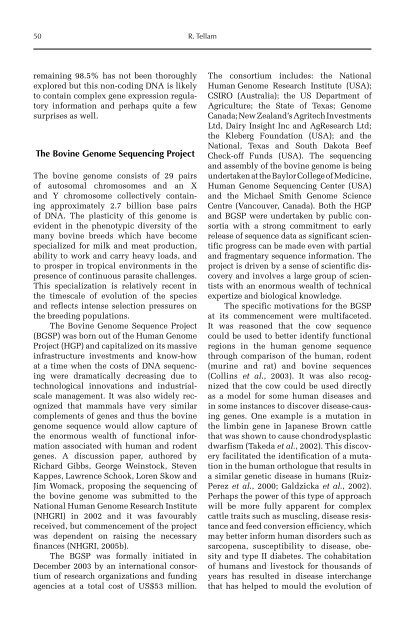Redesigning Animal Agriculture
Redesigning Animal Agriculture
Redesigning Animal Agriculture
You also want an ePaper? Increase the reach of your titles
YUMPU automatically turns print PDFs into web optimized ePapers that Google loves.
50 R. Tellam<br />
remaining 98.5% has not been thoroughly<br />
explored but this non-coding DNA is likely<br />
to contain complex gene expression regulatory<br />
information and perhaps quite a few<br />
surprises as well.<br />
The Bovine Genome Sequencing Project<br />
The bovine genome consists of 29 pairs<br />
of autosomal chromosomes and an X<br />
and Y chromosome collectively containing<br />
approximately 2.7 billion base pairs<br />
of DNA. The plasticity of this genome is<br />
evident in the phenotypic diversity of the<br />
many bovine breeds which have become<br />
specialized for milk and meat production,<br />
ability to work and carry heavy loads, and<br />
to prosper in tropical environments in the<br />
presence of continuous parasite challenges.<br />
This specialization is relatively recent in<br />
the timescale of evolution of the species<br />
and reflects intense selection pressures on<br />
the breeding populations.<br />
The Bovine Genome Sequence Project<br />
(BGSP) was born out of the Human Genome<br />
Project (HGP) and capitalized on its massive<br />
infrastructure investments and know-how<br />
at a time when the costs of DNA sequencing<br />
were dramatically decreasing due to<br />
technological innovations and industrial-<br />
scale management. It was also widely recognized<br />
that mammals have very similar<br />
complements of genes and thus the bovine<br />
genome sequence would allow capture of<br />
the enormous wealth of functional information<br />
associated with human and rodent<br />
genes. A discussion paper, authored by<br />
Richard Gibbs, George Weinstock, Steven<br />
Kappes, Lawrence Schook, Loren Skow and<br />
Jim Womack, proposing the sequencing of<br />
the bovine genome was submitted to the<br />
National Human Genome Research Institute<br />
(NHGRI) in 2002 and it was favourably<br />
received, but commencement of the pro ject<br />
was dependent on raising the necessary<br />
finances (NHGRI, 2005b).<br />
The BGSP was formally initiated in<br />
December 2003 by an international consortium<br />
of research organizations and funding<br />
agencies at a total cost of US$53 million.<br />
The consortium includes: the National<br />
Human Genome Research Institute (USA);<br />
CSIRO (Australia); the US Department of<br />
<strong>Agriculture</strong>; the State of Texas; Genome<br />
Canada; New Zealand’s Agritech Investments<br />
Ltd, Dairy Insight Inc and AgResearch Ltd;<br />
the Kleberg Foundation (USA); and the<br />
National, Texas and South Dakota Beef<br />
Check-off Funds (USA). The sequencing<br />
and assembly of the bovine genome is being<br />
undertaken at the Baylor College of Medicine,<br />
Human Genome Sequencing Center (USA)<br />
and the Michael Smith Genome Science<br />
Centre (Vancouver, Canada). Both the HGP<br />
and BGSP were undertaken by public consortia<br />
with a strong commitment to early<br />
release of sequence data as significant scientific<br />
pro gress can be made even with partial<br />
and fragmentary sequence information. The<br />
project is driven by a sense of scientific discovery<br />
and involves a large group of scientists<br />
with an enormous wealth of technical<br />
expertize and biological knowledge.<br />
The specific motivations for the BGSP<br />
at its commencement were multifaceted.<br />
It was reasoned that the cow sequence<br />
could be used to better identify functional<br />
regions in the human genome sequence<br />
through comparison of the human, rodent<br />
(murine and rat) and bovine sequences<br />
(Collins et al., 2003). It was also recognized<br />
that the cow could be used directly<br />
as a model for some human diseases and<br />
in some instances to discover disease-causing<br />
genes. One example is a mutation in<br />
the limbin gene in Japanese Brown cattle<br />
that was shown to cause chondrodysplastic<br />
dwarfism (Takeda et al., 2002). This discovery<br />
facilitated the identification of a mutation<br />
in the human orthologue that results in<br />
a similar genetic disease in humans (Ruiz-<br />
Perez et al., 2000; Galdzicka et al., 2002).<br />
Perhaps the power of this type of approach<br />
will be more fully apparent for complex<br />
cattle traits such as muscling, disease resistance<br />
and feed conversion efficiency, which<br />
may better inform human disorders such as<br />
sarcopena, susceptibility to disease, obesity<br />
and type II diabetes. The cohabitation<br />
of humans and livestock for thousands of<br />
years has resulted in disease interchange<br />
that has helped to mould the evolution of










